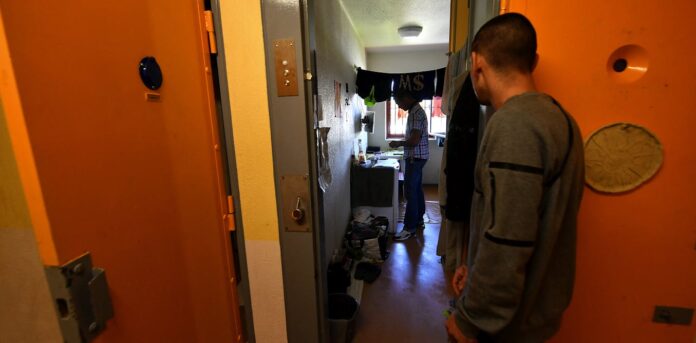How widespread is drug use in prison? In 2023, the French Observatory on Drugs and Addictive Tendencies (OFDT) conducted a big investigation aimed at understanding and quantifying the phenomenon.
According to a widely shared – and partly fantasized – vision, drugs are omnipresent and tolerated in prison in order to “buy social peace”. This subject sometimes arouses indignation: drugs being prohibited outside, the existence of drugs in prison is considered all the more “scandalous” as it would reflect more permissive living conditions within the walls than outside. ‘outside.
For professionals who work in prison, drug trafficking and consumption are part of everyday prison life. Prohibited but nevertheless very present, drug use is embedded in complex social relationships between prisoners, surveillance personnel and the outside world.
These uses are also covered by prison medical teams or by Addiction Care, Support and Prevention Centers (CSAPA) which operate in prisons.
How widespread is the phenomenon? In 2023, we conducted, at the French Observatory of Drugs and Addictive Tendencies (OFDT), a big investigation called ESSPRI (Survey on health and substances in prison) aimed at understanding the phenomenon of drug use during detention.
Cannabis: first illicit substance consumed in prison
The results confirm high levels of drug use in prison.
In 2023, tobacco, the only legal drug in detention, is consumed at very high levels: 63% of prisoners say they smoke it every day. Cannabis consumption is also high: 49% of prisoners have smoked cannabis at least once in prison and 26% smoke it daily. 16% of prisoners have already consumed alcohol (the use of which is prohibited in prison) during their detention.
Use of other illicit drugs is not negligible: for example, 13% of prisoners have used cocaine at least once in detention. In total, half of the prisoners have used an illicit substance at least once in prison. Furthermore, between 1.4% and 5.7% of prisoners have resorted to injecting a drug or substitute product at least once.
(Already more than 120,000 newsletter subscriptions The Conversation. And you ? Subscribe today to better understand the world’s biggest issues.)
This drug use is significant, especially when compared to the entire French population. Daily tobacco use is twice as high among prisoners as in the rest in the male populationand daily use of cannabis is almost ten times higher. Only alcohol, the availability of which is less than other substances (in particular due to greater difficulty in trafficking), is consumed less than outside: 3.7% of prisoners consume alcohol. alcohol at least once a month, while in the French population the half of men drink alcohol at least once a week.
However, these differences must be qualified: the prisoners interviewed already had very high levels of drug use before entering detention. For example, a quarter of them already used cannabis very regularly (more than ten times a month) before entering prison. Conversely, among prisoners who had never used cannabis before entering prison (44%), most of them do not use it after their incarceration.
The prison world is therefore a space for the continuation of uses – among which cannabis occupies a preponderant place – and for certain transfers of consumptionnotably from alcohol to certain psychotropic medications.
Georges Gobet/AFP
Safe care and health care
How is this drug use handled within prison establishments?
They are firstly the subject of a security framework which is based on the principle of a ban on any substance other than tobacco, the use of drugs and the possession of narcotics being considered as “disciplinary faults” in the prison codewith a whole range of possible sanctions in repression.
These uses are also the subject of health care, strongly inherited from the context of the turn of the 1990s, when the problem of “drug addiction”, linked to the AIDS pandemic, entered the public debate and that initial studies have reported a high prevalence of HIV in detention.
By organizing care in a prison environment, the law of January 18, 1994 constitutes the first milestone in the health framework for addictions among detained persons: the general principle, reaffirmed in the health law of 2016is that of an equivalence of care, and therefore of access to the offer of addiction treatment for prisoners.
This support is mainly structured around the identification, during the first medical examination upon entry into detention, of people with addiction problems. Caregivers must, when necessary, set up an “adapted care plan” aimed at weaning and, if necessary, implementing replacement treatments.
Preparation for release must also include an addictions component, entrusted to the CSAPA prison branch. Finally, health personnel must in theory be able to offer “risk and damage reduction” (RdRD) tools, such as the provision of sterile equipment, although the implementing decree of the 2016 law has still not been signed by the ministries concerned.
Tension between care and security
These two perspectives are difficult to reconcileparticularly with regard to the practices of injecting psychoactive substances by prisoners (which concerns less than 5% of prisoners).
If all the stakeholders concerned agree on the need for health care for addictions, the distribution of RdRD equipment to prisoners (sterile syringes, Steribox, crack pipes, Naloxone used to deal with drug overdoses opioids, etc.), widely desired by caregivers, arouses reluctance among surveillance personnel. The absence of a decree implementing the 2016 health law on the RdRD aspect in prison underlines this blockage, even if the recent Roadmap “health of people placed under the supervision of justice 2024-2028”, signed last July , recalled the objective of applying the RdRD policy in prison “according to methods adapted to the prison environment”.

Georges Gobet/AFP
Furthermore, by focusing on uses considered the most “problematic” (crack, opioids, etc.), the health perspective tends to make cannabis consumption (even though very widespread) and its health consequences invisible. Cannabis, which concentrates the majority of drug seizures in prison by the prison administration, is thus managed as a primarily security issue.
Changing the way we look at drugs in detention
Public policies for the treatment of addictions would benefit from further opening their spectrum to the problem of cannabis.
To this end, all stakeholders must become aware that uses are strongly linked to difficult living conditions in detention, particularly in remand centers which are experiencing a endemic prison overcrowding.
For example, when prisoners are asked about the reasons why they use cannabis, they cite therapeutic motivations (to calm down, to fall asleep, etc.) rather than recreational ones (to feel pleasure, etc.). As such, the development of support systems for reducing tobacco consumptioncertainly the only substance legal in detention, can serve as an example.
We can hope, finally, that therecent evolution of global representations on drugs in France, in favor of an approach that is more preventive than repressive, also makes it possible to change the perception of these practices within the walls.

